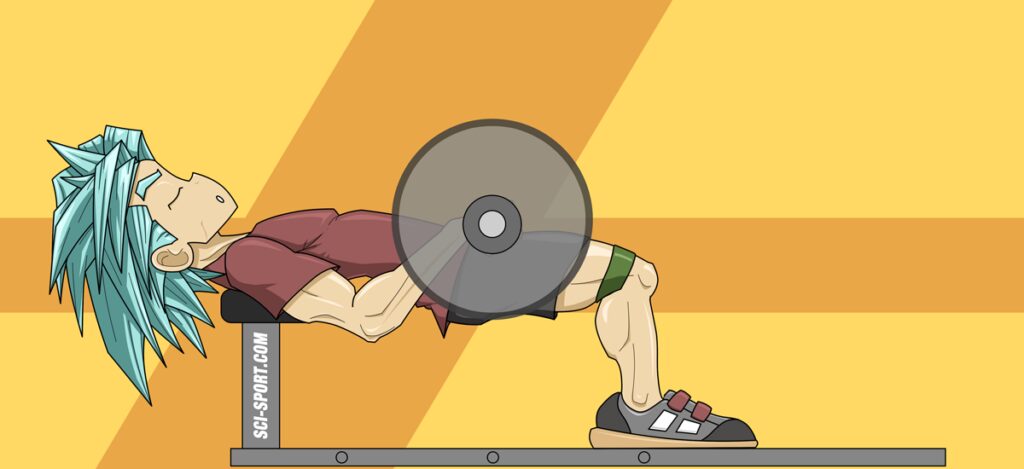Differences in muscles activity during Hip Thrust variations

The large muscles responsible for the hip extension (the hamstrings and the gluteus maximus) have long been studied in the context of injuries prevention among athletes, and in recent years for their leading role in the speed disciplines, such as the 100m sprint. Added to this is the growing interest of fitness enthusiasts trying to hypertrophy these muscle groups.
The Hip Thrust exercise has become a must in this work perspective. Several studies have shown that this exercise allows better recruitment of the hamstrings and the gluteus maximus compared to different squat variants (back squat and front squat). Another study (read our article) showed that in comparison to the deadlift with straight bar and deadlift with hex bar, the Hip Thrust allowed a better recruitment of the gluteus maximus, but not the hamstrings. But what about the impact of different positions during Hip Thrust on muscle activation ?
The Study
To answer this question, a team of researchers from the Polytechnic University of Madrid compared the muscular activity of the lower limbs in 4 variants of Hip Thrust. For this, the researchers recruited 7 men, all personal trainers whose 1RM in Hip Thrust was 153.3 ± 11.0 kg.
Thus, during a first test session, participants tested their 1RM on this exercise. Then, during a second session, they realized the experimental protocol which consisted in performing 8 repetitions at 40% of 1RM, in 4 variants of Hip Thrust, with 3 minutes of recovery between each variant :
- Original Hip Thrust (OHT) (Fig. 1): The feet are slightly wider than the shoulder width and the shins are vertical in the final position.
- Hip Thrust Pull (Fig. 2): Same position as OHT. The only difference lies in the instruction given to participants : “Try to get your heels closed to the glutes during the entire range of motion”. The goal is to maximize muscle contraction.
- Hip Thrust Rotation (RHT) (Fig. 3): The feet are wider than in previous variants and the following instruction was given: “Feel that your feet rotate outwards”. The actual rotation of the toes was allowed as long as the gap between the feet remained the same. The goal according to the authors was to maximize the voluntary force in hip external rotation.
- Feet-Away Hip Thrust (FHT) (Fig. 4): In contrast to the first two variants, the distance of the feet from the bench was increased by the length of the foot.
To analyze the muscular activity, the researchers used surface electromyography on the following muscles : rectus femoris, vastus medialis, vastus lateralis, gluteus maximus, gluteus medius, biceps femoral and semi-tendinous.
Results & Analyzes
The main results of this study show that the gluteus maximus are mainly activated when the feet are placed under the knees, while the hamstrings (the biceps femoral and semi-tendinous) are mainly activated when the feet are placed further forward (Fig. 5).

This study also shows that the instruction has a strong impact on muscle recruitment. Thus, during the RHT variant, the activation of the gluteal muscles increases significantly in comparison with the OHT variant, and the gluteus maximus reaches 86.18 ± 34.30% of maximum voluntary isometric contraction (the load being only 40% of 1RM). Moreover, in the PHT variant, where the participants are supposed to want to bring their heels to the buttocks during the whole movement, the activation of the femoral and semi-tendinous biceps muscles is improved.
Finally, we can note that during the last variant (FHT), moving the feet forward increases the hamstrings activation while decreasing the activation of the knee extensor muscles (rectus femoris, vastus medialis and vastus lateralis).
Practical Applications
This study shows that the placement of the feet and the intention given to the movement have an impact on muscle recruitment during Hip Thrust. The external rotation of the feet is therefore very interesting to maximize the contraction of the glutes, especially that of the gluteus maximus. And moving forward the feet makes it easier to involve the hamstrings.
Concerns can be addressed regarding the intensity chosen in this study. The authors explain that this intensity can be used in training as well as in rehabilitation. And the results show that even with a relatively low intensity, it is possible to obtain interesting results. Yet with only 7 subjects, it would have been interesting to test at 60 and 80% of 1RM, for example. When the loads are heavier, the motor patterns could sometimes be modified. It would have been interesting to have information on this point.
Finally, note that the external rotation of the feet in the flexed knee position does not really have any influence on the external rotation of the hip (which is the muscular action of the gluteus maximus), but the outward feet rotation will allow to spread the knees and eventually cause an external rotation of the hip. So, to get an even more gluteus activation, if you cannot feel it contract enough during exercise, you can add a mini-band just above your knees (see the figure below). Spread your feet to have proper tension in the mini-band and perform the exercise normally without ever letting your knees move closer to each other and without moving your feet. You should feel the tension in your gluteal muscles throughout the entire exercise.
Another variation is to add an elastic band on each side of your bar (if you have equipment that allows it) to maximize muscle contraction at the end of the concentric phase (see figure below). Indeed, the elastic resistance will make the end of the movement even more difficult, and so the contraction of the gluteus maximus.
Reference
Collazo Garcia CL, Rueda J, Suarez Luginick B and Navarro E. Differences in the electromyographic activity of lower-body muscles in Hip Thrust variations. J Strength Cond Res In Press, 2018.





